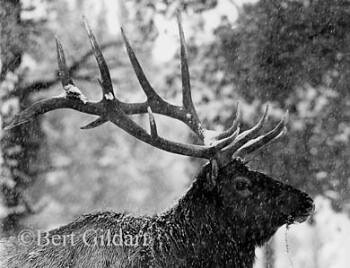Snow Falls over Exhausted Bull Elk
©Bert Gildart: Fall is winding down in our part of the country and winter snows are beginning to blanket some of the higher peaks here in the Flathead. Over the years I’ve managed to photograph one of the most impressive of mammals, the bull elk. From this black and white photo–made with a Hasselblad medium-format camera–I created what has been a very popular print into what is now a 5×7 card, and then added to it several paragraphs of text.

Exhausted bull elk settling in for winter
The card is available from us in various quantities, and if any are interested, you should contact us for price structures. The card, along with 10 others in the series, is sold locally in art galleries around the valley as well as at the airport. Another B&W in the series is shown on a previous posting.
Here’s the text that accompanies this photo.
Bull Elk: Early winter and this royal bull elk (one with six tines) steps forward to test the fury of the winter wind and the bite of the mountain snow, determined to find food on a day that’s none too pleasant. As the snows pile, the once indefatigable energy level of the bull may wane as food becomes scarce. Will the animal endure? Probably, for the elk is wonderfully equipped to thrive in a land where temperatures sometimes dip to 40 below. Undoubtedly he’ll survive to gather his harem again next fall, the latter custom yet another adaptation that enables this magnificent species not only to exist, but to thrive…
A mature bull elk is defined by the number of tines it produces. If a bull has six tines, it is called a Royal; seven, an Imperial; and eight, a Monarch. The antlers below represent those from a Monarch. Of course, young bulls also grow antlers, beginning in their first year. Normally the first antlers are a single spike on each side. Sometimes those first antlers are forked on top, and may even show a single short brow tine.
The next set are known as “raghorns,” and usually consist of four to five points. The third set occurs in a three-year-old elk and it is likely to have less than six points. Mature bulls often‑though not always‑shed between January and February, depending on location. Young males generally shed in March. By April you can see new growth and by May, you can see tines.
A 40-year resident of Montana, Bert Gildart has become a nationally recognized writer and photographer with numerous professional awards. He has written about wildlife extensively. Photo: Bert Gildart

